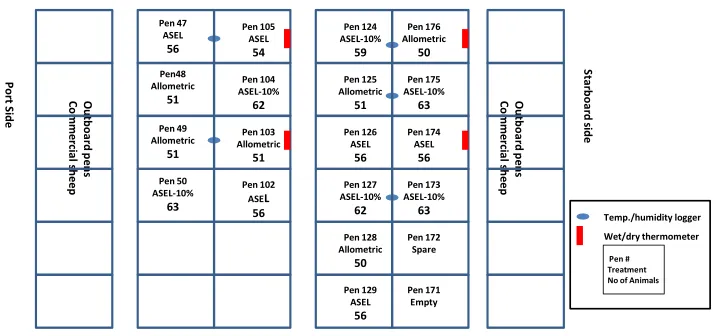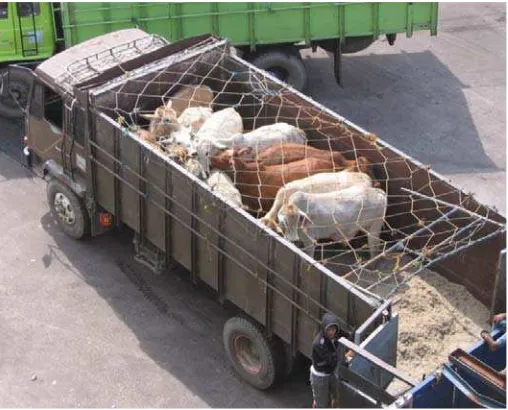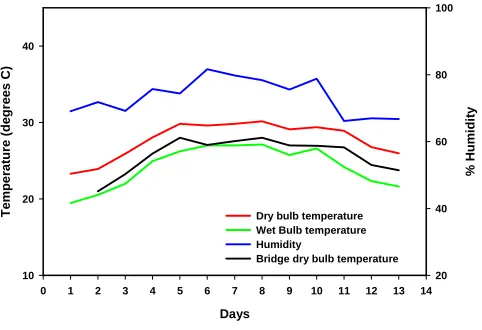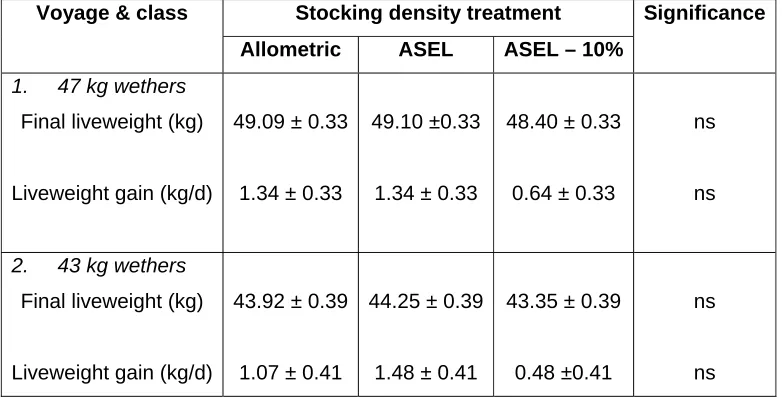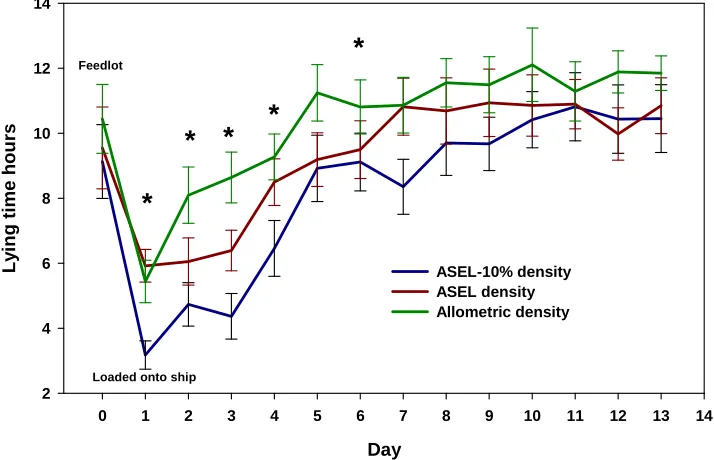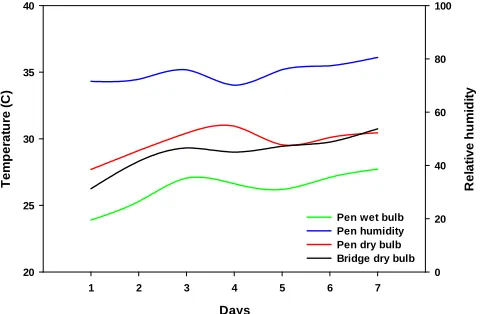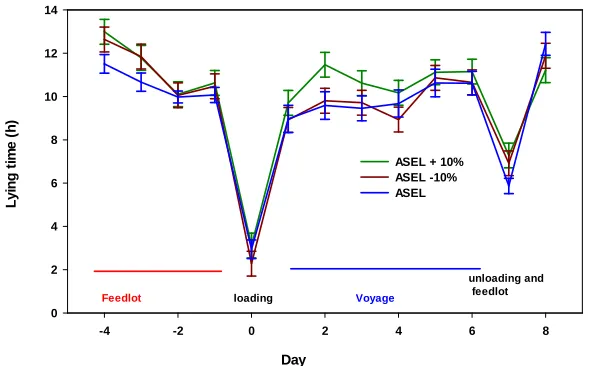final re
port
p
Project code: W.LIV.0253
Prepared by: Drewe Ferguson and Jim Lea CSIRO Animal, Food & Health Sciences
Date published: January 2013
ISBN: 9781741919752
PUBLISHED BY
Meat & Livestock Australia Limited Locked Bag 991
NORTH SYDNEY NSW 2059
Meat & Livestock Australia acknowledges the matching funds provided by the Australian Government to support the research and development detailed in this publication.
This publication is published by Meat & Livestock Australia Limited ABN 39 081 678 364 (MLA). Care is taken to ensure the accuracy of the information contained in this publication. However MLA cannot accept responsibility for the accuracy or completeness of the information or opinions contained in the publication. You shouldmake your own enquiries before making decisions concerning your interests. Reproduction in whole or in part of this
Abstract
Page 3 of 26
Executive summary
There is a paucity of scientific evidence regarding the appropriate stocking densities for the sea transportation of livestock. The livestock stocking densities within the Australian Standards for the Export of Livestock (ASEL) were largely based on the best knowledge available and practical experience. Therefore, this research project was conducted to provide new objective evidence of the welfare outcomes of different space allowances during sea transport of sheep and cattle. The specific objective was to determine the animal welfare outcomes in one class of cattle and two classes of sheep during sea transport at different stocking densities. For each livestock class, three stocking densities were investigated:
(i) current ASEL allowance (ii) 10% less than ASEL
(iii) 10% greater than ASEL or the allometric allowance (0.027 x liveweight0.66), whichever was greater
Two sheep voyages to the Middle East (1011 x 47 kg Merino wethers and 1120 x 43 kg Merino wethers and one cattle voyage to Indonesia (270 x 320 Brahman cross steers) were conducted. The experimental animals were selected based on tight weight specifications from an export consignment of livestock at the pre-embarkation feedlot. Weight change and lying behaviour over the voyage were assessed on a subset of focal animals on each voyage. Lying behaviour, specifically the time spent lying, was determined via IceTag behavioural monitors. The monitors were fitted to the legs of the focal animals and record behavioural events (lying, standing, walking). Environmental conditions in the pens were also monitored.
In general, the results from the three voyages were fairly similar where stocking density or space allowance had no effect on weight gain and no or a transient effect (sheep voyage 1) on lying time. Notwithstanding this, there was a common trend for lying behaviour across the three voyages. When offered more space, animals spent more time lying particularly during the critical initial stages of the voyage. There may be welfare benefits associated with this as it may enable animals to enhance the capacity of the animals to adapt to the voyage conditions. However, caution must always be exercised when interpreting non-significant treatment differences (with the exception of voyage 1 - sheep). Notwithstanding this, the trend was reasonably consistent despite the very small differences in space allowance.
Contents
Page
1
Background ...6
2
Project objectives ...7
3
Methodology...7
3.1 Sheep voyages ... 7
3.1.1 Voyage 1 – 47 kg wethers ... 7
3.1.2 Voyage 2 – 43 kg wethers ... 10
3.2 Cattle voyage ... 12
3.2.1 Experimental design ... 12
3.2.2 Animal selection ... 12
3.2.3 Treatment allocation ... 12
3.2.4 Measurements and monitoring ... 13
3.2.5 Statistical analysis ... 14
4
Results and discussion ... 15
4.1 Results - Sheep voyages ... 15
4.1.1 Animal health and mortality... 15
4.1.2 Ambient conditions during the voyage ... 15
Page 5 of 26
4.2.4 Lying behaviour ... 21
4.3 Discussion ... 22
5
Success in achieving objectives ... 25
6
Impact on meat and livestock industry – now and in
five years time ... 25
7
Conclusions and recommendations ... 25
8
Acknowledgements ... 25
1 Background
The livestock stocking densities that are identified within the Australian Standards for the Export of Livestock (ASEL) were largely based on the best knowledge available and practical experience. Whilst there is scientific evidence of the effects of different space allowances on livestock within indoor housing systems, there have been no comparable studies conducted during transport on board livestock vessels (refer review by Petherick and Phillips, 2007). Furthermore, the current evidence based on land-based studies may not be directly relevant under sea transport by virtue of the unique environmental conditions that prevail (eg. ship movement).
Notwithstanding this, these results have revealed that reductions in space allowance can have large effects on the type and degree of social interactions between animals (see review by Petherick and Phillips 2007). Typically, with increased competition for resources (eg. lying space) which will occur at lower space allowances, there will be a commensurate increase in agonistic interactions. This in turn can significantly affect essential behaviours such as eating and resting/lying. Any reductions in the ability of the animal to eat its normal feed allowance or rest for 6-8 h/day will result in a profound compromise to their welfare.
Page 7 of 26
2 Project
objectives
Determine the animal welfare outcomes in at least one class of cattle and at least two classes of sheep during sea transport at different stocking densities. For each livestock class, there will be three space allowances or stocking densities investigated:
1. current ASEL space allowance 2. 10% less than ASEL
3. 10% greater than ASEL or the allometric allowance (0.027 x liveweight0.66), whichever was greater
3 Methodology
3.1 Sheep voyages
The research activities were approved by the CSIRO Livestock Industries Animal Ethics Committee in Floreat, WA (AEC No. 0903).
The first investigation (47 kg wethers) was conducted on a commercial voyage from Fremantle to Doha (2 - 16 June 2010) and the second investigation (43 kg wethers) was conducted on a commercial voyage from Fremantle to Bahrain over the period 7 – 20 December 2010. Three space allowance or stocking density treatments were investigated:
1. ASEL
2. ASEL - 10 % (ASEL-10%)
3. Allowance based on the allometric equation - Area (m2) = 0.027*liveweight0.66 (Allometric) Each treatment was replicated six times within a single deck on the livestock vessel (ie. total of 18 pens). There were 10 focal animals/pen on which observations were made +(four of these focal animals were fitted with IceTag activity monitors on the left foreleg). These were combined with additional filler animals (of the same weight class) to achieve the desired stocking density in each pen.
3.1.1 Voyage 1 – 47 kg wethers
(i) Animal selection
These were used as filler animals. An additional 20 sheep of the same weight and BCS were also selected as spares to replace any sick or dead animals during the voyage.
The focal and filler groups were kept in separate pens in one of the feedlot sheds. All animals received the standard feedlot ration ad libitum (commercial pellets comprising 21% lupins, 20 % barley and 59% straw; 12% crude protein, 10 MJ ME) and had access to water.
Liveweight and BCS were repeated on the focal animals two days prior to loading on the vessel. In addition, they were ear-tagged with a unique number and a random subset of 72 animals (after stratification for property of origin) were fitted with an activity monitor (Icetag 3D, IceRobotics, Midlothian, Scotland, UK.) on the left foreleg. The IceTags measure the time each focal animal spends, lying, active or standing.
(ii) Treatment allocation.
Based on the liveweight, the treatments in terms of space allowance were as follows: ASEL-10% = 0.2772 m2/head
ASEL = 0.308 m2/head Allometric = 0.343 m2/head
The allometric treatment was selected because it afforded the animal slightly more space allowance than ASEL + 10% (0.339 m2/head).
The focal animals were randomly allocated to treatment groups after stratification for property of origin. On the day of loading the focal animals were transported as a group in one vehicle. These were loaded onto the vessel and held in a large single pen on deck 7. The filler animals were transported at the same time and loaded directly in the pens according the assigned stocking density. The focal animals were then transferred into the pens according to their treatment allocation. The deck plan and allocation of treatments is shown in Figure 1.
Page 9 of 26
Figure 1: Pen layout (deck 7), treatment allocation and animal numbers
(iii) Measurements and monitoring
Wet and dry bulb temperature was measured four times daily (0700, 1100, 1500 and 1900 h) using Mason’s wet and dry bulb hygrometers. Deck 7 temperature and humidity was logged every 15 minutes using TinytagPlus loggers (TGP-1500 Gemini Data Loggers). The location of the hygrometers and loggers is shown in Figure 1. Port and starboard bridge wet and dry temperatures (ambient) were also recorded four times a day.
Animals were monitored four times daily. The IceTags were visually checked and they were adjusted or refitted if necessary. If sick animals were observed they were removed from the pen to a hospital pen and given veterinary treatment. Deceased animals were removed immediately and an autopsy was conducted by the on-board veterinarian. Any animals removed from
treatment pens were immediately replaced by spare filler animal. Animals that were treated were not used again in the experiment.
The animals were fed the same pelleted ration (ad libitum) as described earlier. The troughs were checked and cleaned twice daily and 0700 and 1530 hrs.
On the day prior arrival at Doha (day 13), the focal animals were removed from their pens and weighed and the IceTags were removed.
The IceTag data was downloaded and the proportion of time spent lying during the voyage was determined. The temperature and humidity data was also downloaded.
3.1.2 Voyage 2 – 43 kg wethers
(i) Animal selection
The sheep were sourced from a subset (approx.3500 animals) of an export consignment. The 180 focal animals were selected with a target weight of 43 ± 1.5 kg and a BCS between 2 and 3. The sheep originated from four different properties of origin. A further 940 animal were selected with a liveweight mean of 43 ± 1.5 kg and a BCS between 2 and 3. These were used as the filler animals. An additional 20 sheep of the same weight and BCS were also selected as spares. The focal and filler groups were kept in separate pens in one of the feedlot sheds. All animals received the standard feedlot ration ad libitum. The ration was based on lupins, barley, canola and straw (10.8% crude protein, 10.3 MJ ME).
All other procedures were the same as those described in voyage 1.
(ii) Treatment allocation.
Based on the liveweight, the treatments in terms of space allowance were as follows: ASEL- 10% = 0.2682 m2/head
ASEL = 0.2980 m2/head Allometric = 0.3230 m2/head
The ASEL + 10% space allowance (0.3277 m2/head) was marginally greater than the allometric space allowance. However, given the small difference, the allometric allowance was selected for consistency between voyages.
Page 11 of 26
Figure 2: Pen layout (deck 7), treatment allocation and animal numbers
Measurements and monitoring
Wet and dry bulb temperature was measured four times daily (0600, 1100, 1600 and 2000 hrs) daily using Mason’s wet and dry bulb hygrometers. Deck 7 temperature and humidity was logged every 15 minutes using TinytagPlus loggers (TGP-1500 Gemini Data Loggers) The animal monitoring, and feeding and cleaning procedures were similar to those described for voyage 1. On the day prior to arrival at Bahrain (day12), the focal animals were removed from their pens and weighed and the IceTags were removed and the data was downloaded for analysis.
Statistical analysis
The data were initially checked for normality. The MIXED model procedure in SAS (SAS Institute Inc., Cary, NC, USA.) was then used to analyse the data. In determining the effects of stocking density on final liveweight, the initial model contained the fixed effects of property of origin, stocking density treatment and the covariate initial liveweight plus the interactions. Pen (stocking density treatment) was included as a random term in the model. The experimental unit in this instance was pen. A similar model was used minus the covariate for liveweight gain over the voyage. For the analysis of lying time, the model contained the fixed effects of property of origin, stocking density treatment and day of voyage and their interactions plus the random terms pen (stocking density treatment), pen x day of voyage (stocking density treatment) and animal. Non significant interactions (P>0.05) were sequentially removed to reveal the final model.
3.2 Cattle voyage
The research activities were approved by the CSIRO Livestock Industries Animal Ethics
Committee in Armidale, NSW (AEC No.12/15) and ratified by the Northern Territory Government (Licence No. 042).
3.2.1 Experimental design
Three stocking density treatments were investigated: 1. ASEL
2. ASEL - 10 % (ASEL-10%) 3. ASEL + 10% (ASEL+10%)
The ASEL+10% treatment (1.296 m2/head) was chosen because it afforded slightly more space than that based on the allometric equation (1.216 m2/head).
Each treatment was replicated six times within a single deck on the livestock vessel (ie. total of 18 pens). Four cattle per pen had IceTag activity monitors fitted to their left rear leg. These were combined with additional animals (of the same weight class) to achieve the desired stocking density in each pen.
3.2.2 Animal selection
A total of 270 Brahman cross steers were sourced from a subset (approx. 1500 animals) of an export consignment that was assembled at the Berrimah feedlot in Darwin. The animals were selected from the consignment if they had a target weight of 320 ± 5kg. Each was ear-tagged with a unique number. An additional 10 steers of the same weight were also selected as spares to replace any sick or dead animals during the voyage.
The cattle were kept in separate pens (approximately 600 m2) in their treatment groups at the feedlot and provided with ad libitum feed (commercial pellet 92% DM, 11.0% protein, 10.0% ME and 65.7%DMD) and water.
The animals remained in these pens at the feedlot for a further two days and were then moved to similar sized pens (to free up space at the feedlot) for a further two days. The cattle were
Page 13 of 26
They were offloaded in their pen groups and placed directly into their assigned treatment pens on board the ship. The deck plan and allocation of treatments is shown in Figure 1.
All pens were located in the inboard and forward section of deck 7 of the vessel. Deck 7 is an open deck but also receives mechanical ventilation. Each pen contained three feed troughs and one water trough, measuring 25 x 25 x 79 cm. The troughs were located on the outside of the pens, and therefore did not reduce space allowance.
Figure 3: Pen layout (deck 7), treatment allocation, pen area and animal numbers/pen.
3.2.4 Measurements and monitoring
Wet and dry bulb temperature was measured four times daily (0700, 1100, 1500 and 1900 h) using Mason’s wet and dry bulb hygrometers. Deck 7 temperature and humidity was also logged every 15 minutes using TinytagPlus loggers (TGP-1500 Gemini Data Loggers). The location of the hygrometers and loggers is shown in Figure 1. Port and starboard bridge wet and dry temperatures (ambient) were also recorded four times a day.
The cattle were fed the same pelleted ration (ad libitum) as described earlier. They were monitored four times daily and the troughs were checked and cleaned twice daily at approximately 0700 and 1530 hrs local ship time.
On arrival at the port of Tanjung Priok (day 4), Jakarta, the animals were loaded onto small trucks (Figure 4 - approximately 13 animals per truck) and transported to the Agrisatawa feedlot. The feedlot was 80 km by road, however, it took approximately 5 h to complete the journey. The unloading of the experimental cattle took approximately 7 h to complete. The 270 experimental cattle were randomly assigned to one of three pens at the Agrisatwa feedlot. The following day the animals were weighed and the IceTags were removed and downloaded.
Figure 4: Transport of cattle from the vessel to the Indonesian feedlot.
3.2.5 Statistical analysis
The data were initially checked for normality. The MIXED model procedure in SAS (SAS Institute Inc., Cary, NC, USA.) was then used to analyse the data. In the analysis of the effect of stocking density on final liveweight, the initial model contained the fixed effects of stocking density
treatment and the covariate initial liveweight plus the interaction. Pen (stocking density
Page 15 of 26
4 Results
and
discussion
4.1 Results - Sheep voyages
4.1.1 Animal health and mortality
The overall level of ill health and mortality in the experimental animals (focal + filler animals) was very low (mortality < 0.5%; includes focal + filler animals) on both voyages.
On the first voyage (47 kg wethers), five animals from the treatment pens (3, 1 and 1 from the allometric, ASEL and ASEL-10% treatments, respectively) and one from the spare pen were removed due to ill health. Two animals died (1 allometric and 1 spare animal) whilst under veterinary observation and another had to be euthanized (1 allometric). The remaining animals recovered and were returned with the spare animals.
In addition, another three animals (1 ASEL, 1 ASEL-10% and 1 spare animal) were found dead in their pens. The diagnosis for the cause of death was inanition stress (n =5) and generic enteritis (n = 1).
On the second voyage (43 kg wethers), two animals were removed from their treatment pens (1 ASEL and 1 allometric) for veterinary inspection. The animal from the ASEL treatment group subsequently died and the primary cause of death was severe enteritis.
4.1.2 Ambient conditions during the voyage
The daily average dry bulb temperature, wet bulb temperature and relative humidity measured on the deck and bridge (dry bulb temperature only) during voyages 1 and 2 are displayed in Figures 5 and 6, respectively.
Figure 5: Average daily pen temperature and humidity – Voyage 1 (2 - 16 June 2010)
Figure 6: Average daily pen temperature and humidity – Voyage 2 (7 – 20 Dec.
Page 17 of 26
4.1.3 Liveweight
All treatment groups gained weight during both voyages (Table 1). However, there were no significant stocking density treatment effects on liveweight gain or final liveweight.
Notwithstanding the lack of significance, it is worth noting that the lowest liveweight gain on both voyages was observed in the low space allowance treatment (ie. ASEL – 10%). A significant property of origin effect (P<0.01) was observed for the 43 kg wethers (Voyage 2).
Table 1: Least square means (± se) for final liveweight and liveweight gain for voyages 1
(47 kg wethers) and 2 (43 kg wethers).
Voyage & class Stocking density treatment Significance
Allometric ASEL ASEL – 10%
4.1.4 Lying behaviour
The animals from both voyages had an average lying time in the feedlot of 10 hours on the day prior to transport to the ship. Once on board, the pattern of lying behavior was reasonably similar over both voyages. Relative to the feedlot, there was an initial reduction in the proportion of time spent lying time followed by a gradual increase to approximately 10-11 h/day as the voyage progressed.
During the first voyage, the sheep had reached the equivalent lying time to that observed in the feedlot on day 4, 6 and 7 for the allometric, ASEL and ASEL-10% treatments, respectively. In the second voyage, this was achieved by day 6 across the treatments.
Sheep in the low space allowance treatment (ASEL-10%) spent significantly less time lying than the higher space allowance treatments during the initial stages of the voyage. This trend was still apparent during the latter half of the voyage except the differences were not significant.
Stocking density treatment or the interaction between stocking density treatment x day of voyage were not significant in the case of the second voyage (43 kg wethers). The interaction is shown in Figure 8 for comparative purposes. Although not significant, the treatment trends for the time spent lying were similar to those observed in voyage 1.
Lying behavior was significantly influenced by property of origin (Voyage 1) and it approached significance (P=0.07) in Voyage 2.
Figure 7: Interaction between stocking density treatment and day of voyage (LS means ±
se) for lying time – Voyage 1 (P<0.05)
Day
0 1 2 3 4 5 6 7 8 9 10 11 12 13 14
Ly
ing time
h
ours
2 4 6 8 10 12 14
ASEL-10% density ASEL density Allometric density
Feedlot
Loaded onto ship
*
*
*
*
Page 19 of 26
Figure 8: Interaction between stocking density treatment and day of voyage (LS means ±
se) for lying time – Voyage 2 (P>0.05).
The results arising from the two sheep voyages are discussed in detail in Appendix 1. Only a summary of the main findings is presented in the following:
• Stocking density treatment did not significantly affect final liveweight on both voyages. However, there was a trend for lower liveweight gains when sheep were provided with lower space allowance (ASEL – 10%).
• Incidences of ill health and mortality were low on both voyages, with one animal from the ASEL and ASEL -10% treatments and two animals from the allometric treatment group dying on voyage 1. There was only the one mortality on voyage 2 (ASEL treatment). There were no differences between the treatments groups. • There was a significant property of origin effect on liveweight gain for voyage 2
(43kg wethers) and lying behaviour for voyage 1 (47 kg wethers). The latter also approached significance for voyage 2.
• Animals in all treatment groups displayed reduced lying time over the initial stages of both voyages, compared to that observed in the feedlots. Comparable lying times were seen after day 4-6 of the voyage.
• There was a significant interaction between treatment x day of voyage in voyage 1 (47 kg wethers), with animals in the lowest space allowance treatment (ASEL – 10%) spending significantly less time lying than those with a higher space
allowance (days 1, 2, 3, 4, and 6). This trend continued throughout the remainder of the voyage, but the differences were not significant.
• For voyage 2 (43 Kg wethers), lying trends between treatments followed the same patterns as voyage 1, but the differences were not significant.
4.2 Results - Cattle voyage
4.2.1 Animal health and mortality
The voyage was successfully completed during the period 14-22 June 2012. There were no mortalities and no animals had to be removed from their pens due to ill-health. One animal however, from the ASEL + 10% treatment group was treated with broad spectrum antibiotic (Draxxin) as a precautionary measure against respiratory disease.
4.2.2 Ambient conditions during the voyage
The daily average dry bulb temperature, wet bulb temperature and relative humidity measured on the deck and bridge (dry bulb temperature only) during the voyage is presented in Figure 9. There was a steady increase in both temperature (dry and wet bulb) and relative humidity during the course of the voyage. Despite this, there was no evidence of elevated respiration rates evident in the cattle during the regular daily monitoring by the project veterinarian on the vessel.
Figure 9: Average pen wet and dry bulb temperatures and relative humidity and bridge dry bulb
temperature (14 – 22 June 2012).
Page 21 of 26 Table 1: Effect of stocking density treatments on final liveweight and liveweight gain.
Stocking density treatment Significance
ASEL + 10% ASEL ASEL – 10%
4.2.4 Lying behaviour
Stocking density treatment had no significant effect on lying behaviour during the voyage (days 1 - 6, Figure 4). Increased lying was observed in the lower stocking density (ASEL + 10%) relative to the other two treatments, particularly during the initial stages of the voyages but the
differences were not significant. Day of voyage (P<0.01) was found to affect lying behaviour. This was primarily due to the higher lying time on days 2, 5 and 6 compared to day 1. There was also a slight reduction (P<0.01) in lying time on day 4 compared to days 5 and 6. This was probably associated with unloading of some animals from the export consignment at Panjang on day 4. The differences overall were relatively small and it was evident that the cattle habituated to the voyage and pen conditions relatively quickly.
Lying time tended to decline in the Australian feedlot which was attributed to the additional movement of the treatment groups to free up feedlot pen space.
Figure 4: Lying time at the Australian (pre-voyage) and Indonesian feedlots (post-voyage) and
4.3 Discussion
In their review on stocking density during sea transport, Petherick and Phillips (2007) concluded that there was a paucity of scientific evidence that was relevant to sea transportation of livestock. Given this and by inference, the lack of objective data to support the current ASEL space
allowances, they recommended research be conducted to evaluate a range of space allowances during sea transport. This research project has addressed this knowledge gap and provided new objective evidence of effects of different space allowances on indicators of welfare during sea transport of sheep and cattle.
Before discussing the results it is pertinent to consider the methodology used in the project, specifically the criteria used to determine animal welfare outcomes. Whilst there are a range of behavioural and physiological measures that could have been applied in the context of assessing animal welfare, we relied on three simple but highly informative measurement criteria:
1. Change in liveweight
2. Change in lying behaviour or time spent lying 3. Incidence of ill-health or disease
Changes in space allowance are known to have large effects on the type and degree of social interactions between animals (see review by Petherick and Phillips 2007). Typically, with
increased competition for resources (eg. lying space) which will occur at lower space allowances, there will be a commensurate increase in agonistic interactions. This in turn can significantly affect essential behaviours such as eating and resting/lying. Any reductions in the ability of the animal to eat its normal feed allowance or rest for 6-8 h/day will result in a profound compromise to their welfare. The impact of reduced lying has been demonstrated in several cattle studies (eg. Fisher et al 2002, 2003). For example, Fisher et al (2002) reported down-regulation of the primary stress axis (hypothalamic-pituitary-adrenal (HPA) axis) as a consequence of periodic lying deprivation (15 h over 7 days) in lactating dairy cows. Under the circumstances of reduced feed and/or rest, the associated stress may also compromise immune function which can
Page 23 of 26
allow all animals to lie in a semi-recumbent position (lying on sternum, semi-supported by legs which are folded against the body) (Petherick and Phillips 2007). For the cattle voyage, the ASEL+10% allowance was chosen but once again it would have provided sufficient space for all animals to lie in a semi-recumbent manner. Apart from the obvious increase in space and reduced competition for available space, the other benefit of fewer animals/pen is that stability in social hierarchy should have been achieved more rapidly. However, the relevance of the latter may be minor when the pens and therefore pen-group sizes are much larger. For experimental reasons, smaller pens were utilised for the two sheep voyages (approx. 17.5 m2) which is typically not the norm.
It is also worth noting that sheep and cattle occasionally lie in a fully recumbent position (lying lateral with legs fully extended) (Petherick and Phillips 2007). The space required for this can be calculated using the allometric equation A = 0.047W0.66 (Petherick and Phillips 1997). In the current study, this would equate to 0.56 and 0.6 m2/head for sheep (43 and 47 kg, respectively) and 3.15 m2/head for cattle (320 kg) which is approximately double that of the highest space allowance treatment. The animal welfare impacts of being unable to lie in a fully recumbent position for several days are not well defined.
Some inference can be gained from the results of indoor housing studies in cattle. Apart from the obvious behavioural effects (eg. reduced lying), there is the potential for animals to experience increased psychological stress (as indicated by HPA axis response) as a consequence of reduced space allowance. However, the results examining the physiological responses of groups of housed cattle to restricted space allowance in experiments have not been consistent. Fisher et al. (1997a) observed reduced basal cortisol levels and ACTH-mediated peak cortisol responses in cattle housed at 1.5 m2 compared to 3.0 m2 but there were no differences in their subsequent study (Fisher et al. 1997b) examining these stocking densities. Furthermore, cattle at the higher density had significantly lower average daily gains (25 – 31 % reduction) compared to those at 3.0 m2/animal. These two space allowances are very close to the allometric space required for semi-recumbent and fully recumbent lying for the weight class of animal used in the studies by Fisher et al (1997ab). However, a key point to make here is that these were indoor housing studies where the cattle were kept at these densities for 140 (Fisher et al 1997a) and 104 days (Fisher et al 1997b). This is significantly longer than the typical voyage durations to the Middle East (11-14 days).
One solution might be to consider practical approaches to drafting export consignments based on size/weight at the feedlot. The size/weight sub-groups could then be stocked at the appropriate density on the vessel.
Property of origin was a significant effect for liveweight gain (Voyage 2) and lying behaviour (Voyage 1) and approached significance for lying behaviour in voyage 2. The reason for this effect is probably due to a range of different factors associated with the property(s) of origin. These may include genetic factors such as temperament and environmental factors such as background nutrition and animal management. This source of variance may be worth investigating further, specifically to identify sheep that are more adaptable to live export conditions.
Page 25 of 26
5 Success in achieving objectives
The primary objectives of the project were achieved successfully. In addition, the project facilitated the development and training of new scientific capability. Jim Lea (CSIRO) utilised experiments within this project as part of his MSc studies.
6 Impact on meat and livestock industry – now and in five
years time
The goal of this project was to deliver objective evidence on the animal welfare outcomes of different stocking densities during live export of livestock. This is the first evidence of its kind where the experiments were conducted under actual voyage conditions. The new evidence from this project in relation to the impact of stocking density will enable the Live Export industry, to make more informed judgements about whether the current ASEL space allowances are appropriate on animal welfare grounds.
In five years’ time, the peer-reviewed, internationally-published information generated by this project will continue to place the industry in good position to defend the welfare outcomes of the ASEL stocking densities during sea transport.
7 Conclusions
and
recommendations
It was concluded that the current ASEL stocking densities are appropriate based on the animal welfare indicators applied in these investigations. However, in the interests of continued refinement of live export standards, the suggested benefits of a small increase above the ASEL space allowance, particularly during the critical early stages of a voyage, are worthy of further consideration and evaluation. The new evidence presented here provides an animal welfare context to assist in these deliberations. However, it is recognised there will be economic, regulatory and public perception factors and trade-offs that will also need to be considered.
8 Acknowledgements
9 Bibliography
Fisher AD, MA Crowe, DJ Prendiville and WJ Enright, 1997a. Indoor space allowance: effects on growth, behaviour, adrenal and immune responses of finishing beef heifers. Anim. Sci. 64:53-62.
Fisher AD, MA Crowe, P O'Kiely and WJ Enright, 1997b. Growth, behaviour, adrenal and immune responses of finishing beef heifers housed on slatted floors at 1.5, 2.0, 2.5 or 3.0 m2 space allowance. Livest. Prod. Sci. 51:245-254.
Fisher, AD, Verkerk, GA, Morrow, CJ and Matthews, LR (2002). The effects of feed restriction and lying deprivation on pituitary-adrenal axis regulation in lactating cows. Livest. Prod. Sci.,
73: 255-263.
Fisher, AD, Stewart, M, Verkerk, GA, Morrow, CJ and Matthews, LR (2003). The effects of surface type on lying behaviour and stress responses of dairy cows during periodic weather-induced removal from pasture. Appl. Anim. Behav. Sci., 81: 1-11.
Gonyou, HW, Stookey, JM and McNeal, LG. (1985). Effects of double decking and space allowance on the performance and behaviour of feeder lambs. J. Anim. Sci. 60:1110-1116. Petherick, JC and Phillips, CJC (2007). Investigating stocking densities in pre-export assembly
